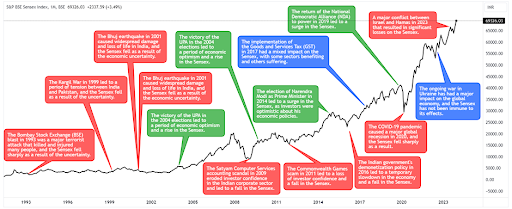The Sensex saga: Explore pivotal moments from political victories to global crises that shaped India's premier stock index in this article.
Buckle up, stock market enthusiasts! The Sensex, India’s premier stock index, has just reached a colossal milestone: crossing the 70,000 mark! This is not just a number on a screen; it’s a story of skyrocketing businesses, booming industries, and the collective wealth of a nation soaring to new heights. Get ready for a thrill ride through 15 key events that paved the way for this historic achievement, where we’ll peek behind the curtain of economic triumphs, policy shifts, and moments of sheer market magic that propelled the Sensex to its 70,000 glory!
BSE Sensex

Here are the details of the 15 mega events of the Sensex:
- BSE Blast (1993): The Bombay Stock Exchange (BSE) blast in 1993 caused the Sensex to fall by 2,300 points. The incident underscored concerns about the security of financial institutions and left a lasting impact on market sentiment.
- Kargil War (1999): The Kargil War between India and Pakistan in 1999 led to a 4500-point dip in the Sensex. Geopolitical uncertainties and the potential impact on regional stability prompted a cautious approach among investors.
- Bhuj Earthquake (2001): The devastating earthquake in Bhuj, Gujarat, on January 26, 2001, resulted in a 4320-point decline in the Sensex. The natural disaster highlighted the vulnerability of financial markets to unforeseen events.
- 9/11 Attack (2001): The Sensex dropped by 2,990 points following the tragic 9/11 terrorist attacks in the United States. Global uncertainty and fear rippled through financial markets, leaving a lasting impact on the trajectory of the Sensex.
- UPA Win 2004: The victory of the UPA in the 2004 elections led to a surge in the Sensex, which reached a high of 5,700 in May 2004. Investors were optimistic about the UPA’s pro-reform policies and its commitment to economic growth.
- Satyam Scam 2009: The Satyam Computer Services scam in 2009 was a major accounting fraud that led to a loss of billions of dollars. The scam led to a loss of confidence in the Indian IT sector and a decline in the Sensex, which fell to a low of 9,424 in January 2009.
- UPA Term II 2009: The return of the United Progressive Alliance (UPA) government to power in 2009 led to a recovery in the Sensex, which reached a high of 14,600 in January 2010. Investors were optimistic about the UPA’s pro-poor policies and its commitment to fiscal discipline.
- Commonwealth Scam 2011: The Commonwealth Games scam in 2011 was a major corruption scandal that led to a loss of billions of rupees. The scam led to a loss of confidence in the government and a decline in the Sensex, which fell to a low of 19,100 in November 2011.
- Narendra Modi as PM 2014: The election of Narendra Modi as Prime Minister in 2014 led to a surge in the Sensex, which reached a high of 24,200 in May 2014. Investors were optimistic about Modi’s pro-business policies and his promise to reform the economy.
- Demonetization 2016: The government’s decision to demonetize high-value currency notes in 2016 led to a significant drop in the Sensex, which fell to a low of 26,500 in November 2016. Demonetization led to cash shortages and disruptions in the economy.
- GST Implementation 2017: The implementation of the Goods and Services Tax (GST) in 2017 was a major reform for the Indian economy. The GST is a value-added tax that applies to all goods and services. The implementation of the GST led to some initial disruption in the economy, but the Sensex eventually recovered and reached a high of 32,500 in January 2018.
- NDA Second Term 2019: The return of the National Democratic Alliance (NDA) government to power in 2019 led to a surge in the Sensex, which reached a high of 39,700 in October 2019. Investors were optimistic about the NDA’s pro-business policies, which they believed would boost economic growth.
- Covid 2020: The Covid-19 pandemic had a devastating impact on the global economy, and the Sensex plunged to a low of 29,500 in March 2020. The pandemic led to lockdowns and business closures, which caused a sharp decline in economic activity.
- Ukraine-Russia War 2022: The war in Ukraine has had a major impact on the global economy, and the Sensex has not been immune. The war has led to sanctions on Russia, which has disrupted trade and investment flows. The Sensex fell to a low of 56,250 amid the war.
- Israel-Hamas 2023: The ongoing conflict between Israel and Hamas in 2023 caused a significant drop in the Sensex, reaching a low of 63,800. The conflict has led to increased uncertainty in the market, as investors worry about the potential impact of the fighting on the global economy.
Disclaimer: This blog has been written exclusively for educational purposes. The securities mentioned are only examples and not recommendations. The information is based on various secondary sources on the internet and is subject to change. Please consult with a financial expert before making investment decisions.

